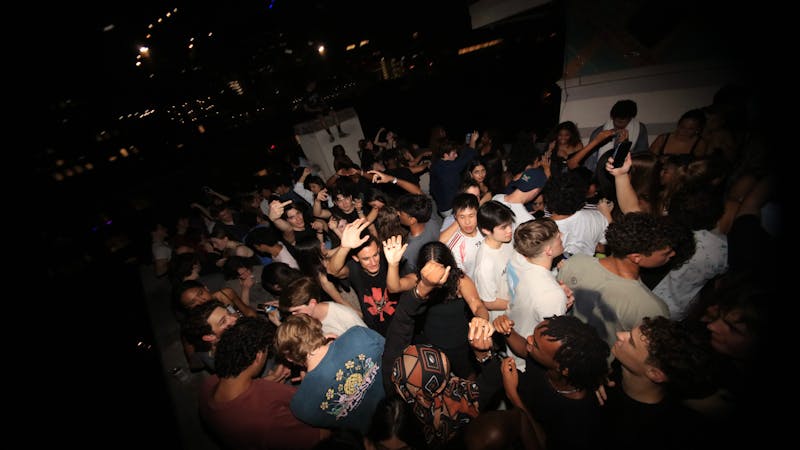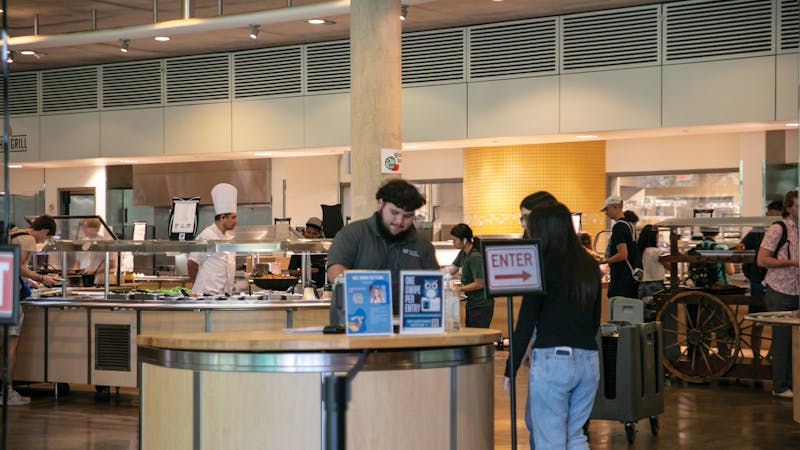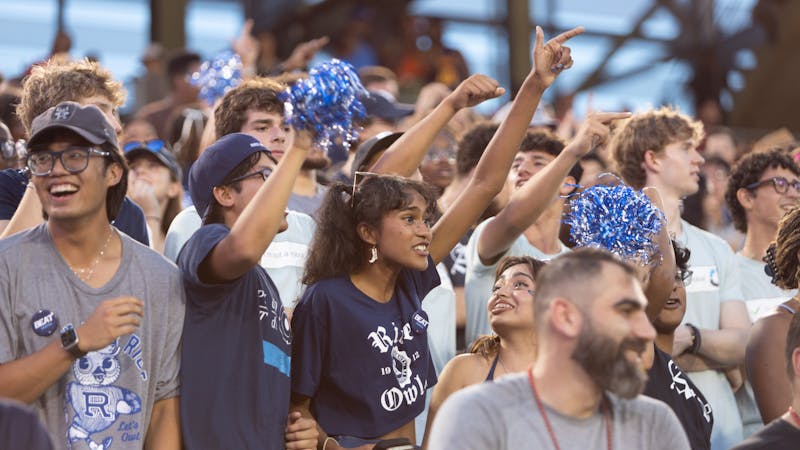“Down With Willy” sit-ins expand to broader movement with Lovett Hall and residential college projections

The sit-ins to remove William Marsh Rice’s statue from the Founder’s Memorial expanded to include projections of messages onto Lovett Hall on Oct. 5, which prompted Rice University Police Department to respond and shut down the display. The sit-ins have continued for over 40 days, with 14 people attending Monday’s sit-in and two additional students on Zoom.
President David Leebron said the administration has acknowledged William Marsh Rice’s ownership of at least 15 enslaved people in many contexts, and it is being publicly acknowledged and discussed in the work of the task force on slavery, segregation and racial injustice. Leebron said the administration is open to hearing other ways for Rice to recognize this history before the task force finishes its work.
“We appreciate it when students voice their opinions,” Leebron said. “The students protesting at the statue are welcome to do so, as long as they comply with Rice policies, do not deface the statue and abide by our pandemic rules.”
Leebron said part of the mission of the task force includes a broad examination of the university’s physical environment, including its architecture and landmarks. Leebron said he expects a conversation with the Rice community to take place in the spring.
“A number of people have suggested different ideas not only about the statue but also how Rice should fully recognize its history,” Leebron said. “We want to have a discussion of those subjects within our broader community after the task force has completed its research, and we will look at all views and alternatives ... What we’ve already heard tells us that no segment of our community has a uniform view of how issues relating to the statue should be addressed.”
Shifa Abdul Rahman, the original organizer of the sit-ins, said he thinks the question about views concerning the statue is not about uniformity, but rather about what properly shows Rice to be an anti-racist and a pro-Black institution.
“There's no way keeping a statue of its racist slave-owning founder in the Academic Quad shows that [Rice is an anti-racist institution],” Rahman, a Lovett College junior, said. “White supremacy was the uniform opinion of Rice University for over 50 years [before the first Black student at Rice matriculated in 1965.]”
The projections
According to a Lovett senior who has taken a lead role with the projections, Indivisible Houston sent two individuals who provided the equipment necessary to project onto Lovett Hall on Oct. 5.
Editor's Note: The Thresher granted anonymity to the student helping organize the projections to protect them from backlash and potential disciplinary consequences.
“We had been trying projections on the Sallyport but we have a really small projector,” the student said. “[Indivisible Houston] brought a projector that was four times as huge, like the size of a table.”
Indivisible Houston is a local nonprofit organization that advocates for an inclusive coalition in Houston through education, engagement and resistance, according to the organization.
“We heard about the action on campus because we've been in contact with Rice for Black Lives since earlier this year,” the organization wrote in an email to the Thresher. “They reached out to coordinate and we were glad to help. We stand in solidarity with Rahman and the rest of the Rice community that chooses to uproot the racist icons of our past.”
Last week, projections of Rice’s racist founding were also displayed from the sixth floor of Lovett College onto the Lovett quad. The student helping organize the projections said that the organizers told students to peek outside their dorm window and see what was going on.
“Part of the projections is about turning the volume up on the protest, and it's super hard to get visibility,” the student said. “Even when we sit-in at the statue every day, not a lot of people necessarily walk by, but everybody's in their dorm rooms right now so projecting at the residential colleges is a really good way for us to gain visibility.”
The student said they believe using projections increases campuswide engagement and discussion, as well as provokes additional questions.
“As an art piece, projecting onto buildings can also lead to some interesting questions,” the student said. “Is Rice, the institution, not the person ... racist or upholding racist values? How does the racist foundation the University was built upon have lasting impacts today?”
The student said that the goal is to project at every residential college and that the organizers reached out to the student leaders and magisters for permission to project at Lovett College and for an upcoming projection at Will Rice College, which was granted.
“We have one planned for Will Rice this upcoming week,” the student said. “And in discussion, Leebron’s house has also kind of come up but it’s a really fine line to walk, since it’s private property of someone’s personal house. Indivisible Houston has tried to help us with the legality of things since they do projections in downtown Houston all the time and have a lot more encounters with police, but there’s just not any clear precedent on whether [all this] is legal or not.”
Incident with RUPD
RUPD directed the projection organizers to shut down the Lovett Hall projections on Oct. 5, according to RUPD Chief Clemente Rodriguez.
“We received a call from a staff member about a bright light shining on Lovett Hall with a message saying William Marsh Rice is a racist,” Rodriguez said.
Jacob Tate, a McMurtry College junior, said he saw that the projections were going to occur through a friend’s Instagram account and decided to come see them in person. However, Tate said RUPD identified him as the responsible party for the projections onto Lovett Hall. (Disclaimer: Jacob Tate is a senior writer for the Thresher Arts and Entertainment section.)
“I'm just standing around, and a golf cart with RUPD officers pulls up, and immediately comes up to me,” Tate said. “And they said, ‘what is this’ [the projections]? And I was like, ‘it's art’, because I do think it is projection art. And they [ask for my ID] and radio it over and say ‘okay, you're the responsible party for this activity. If [Student Judicial Programs] is ever going to pursue anything, it's going to be on you. You are responsible for all these activities.’”
According to Rodriguez, the RUPD supervisor for the shift advised the officers to take the names of students who were there as a matter of record for the call slip, so RUPD would have the names in the event the information was needed or requested.
Tate said there was no indication he was involved in the first place, as he was just standing watching the projections and there were eight or nine other people around.
“If someone else just happened to be walking by for those two minutes, [RUPD] could have grabbed them and named the responsible party,” Tate said. “Everyone involved didn’t want a problem, so it got shut down, but I couldn't have even enforced them to take it down. I was just there to watch.”
Tate said he feels that it should scare the Rice community that RUPD seems comfortable designating the first person they see in a minute as the responsible party since it shows that there are a lot of assumptions playing into who gets designated the responsible party in the first place.
“This means that there's probably been a lot of situations at Rice where people are unfairly targeted because of assumptions,” Tate said. “I think that this is an indictment of RUPD in their methods … and I think that these are very real instances where RUPD is not serving our community and they're not doing their duty, and we need to seriously look into whether they're even trying to gather facts or just trying to make someone culpable.”
Tate said that in blurrier situations than this, RUPD’s tendency to identify a “primary responsible party” can be very harmful.
“[For example], who’s fault is [the occurrence of] a crazy party, or if a few people are jumping hedges or something, who is the one person they’re going to grab? I think that is very problematic,” Tate said.
Rodriguez said RUPD determines if a person is responsible for an incident through known facts and investigation.
“The officer was gathering facts and not determining guilt,” Rodriguez said. “Responsible persons are determined by their involvement in an incident, if it can be determined. In this case the student indicated it was an art exhibit and he did not know he needed permission to display on the building, giving the officer the impression he was responsible. The student also asked what was the process for getting permission, indicating he was responsible.”
Rodriguez said he is unaware of any laws regulating the unauthorized shining of lights onto buildings.
“The protestors were asked to stop projecting their message on the building because they had not requested approval to use Lovett Hall for this type of demonstration,” Rodriguez said.
According to Rice University’s policy on campus demonstrations, protests and organized expressions of opinion, organizers must contact RUPD 48 hours in advance to request permission for the activity. The policy states that failure to provide a required notice in advance may increase the probability that the activity will not be approved due to a lack of time for planning.
According to Rodriguez, earlier in the semester, someone placed a poster and a chain around the statue’s neck. More recently, messages were written in chalk on the statue’s base. Rodriguez said to his knowledge, no disciplinary action was taken against any of the protestors.
The protests at the statue
According to Tate, the projections and the sit-ins are distinct from each other, although both are different parts of a similar movement in the reckoning of Rice’s racist past. Tate said he enjoys the atmosphere of the sit-ins because it provides a space for people to decompress as well.
“Some people come there with readings to do, some come with biochemistry tests to study for, some come there to talk about the movement or about politics,” Tate said. “It's nice to have a time blocked out where I can’t schedule meetings … so for me, it's the time to talk to people, to read books.”
Rahman said that the protestors are advocating for the removal of the bronze statue, not the concrete plinth.
“What the statue does is still emblematize William Marsh Rice’s racist past, history of attachments with the Confederacy and the very nature in which he founded the university [for only white inhabitants],” Rahman said.
Leebron said the trustees of the university would need to approve any decision to remove or relocate the statue, as well as the installation of any monuments that would appropriately recognize related aspects of Rice’s history.
In a guest opinion piece for the Thresher this summer, Jacob Saldinger (Sid Richardson College ’16) wrote in favor of keeping the statue. In an email to the Thresher this week, Saldinger wrote that the statue is not a celebration of William Marsh Rice’s faults and should remain standing to commemorate how Rice's dedication to higher education resonates with all of us today.
“There is immense value in calling attention to how the magnanimous deeds of an individual coupled with a vision can positively transform the community,” Saldinger said. “Both through primary sources of the sculptor and specific artistic symbols found throughout the statue, the Founder’s Memorial was undeniably cast to recognize Rice's role as the university's founder and his commitment to higher education.”
John Greiner, a lecturer for the department of computer science at Rice, wrote an independent comment on a Thresher Facebook post that Willy’s statue has taken a separate meaning over time from William Marsh Rice as a person.
“The statue has been a gathering place, a prank site, a T-shirt design and many other things,” Greiner wrote. “When gathering at the statue, few people are thinking about [William Marsh Rice] and what he did. I think few people really care much about it representing [William Marsh Rice]. What they care about are their individual memories associated with events around the statue.”
Rahman said passersby have engaged in mostly respectful dialogue with the students at the sit-ins, but occasionally they encounter people who are unwilling to listen in terms of talking about the statue and Rice’s history.
“[One woman] was saying this wasn’t the right fight we were going to make, and saying that since she was a person of color, this wasn’t the impression we should be going for … and then saying ‘Rice used to be full of nerds — I don’t know what y’all are,’” Rahman said.
Rahman said he thinks that this protest has become an avenue for the task force to show evidence about discontent regarding the statue.
“If your purpose as a task force … is unpacking the history of slavery and racial justice and how that relates to Rice … and if there is dissent from the task force against the removal of the statue, it [raises the question] for the task force of how much work they were really doing that is actually for racial injustice,” Rahman said.
Alexander Byrd and Caleb McDaniel, co-chairs of the task force, did not respond for comment at the time of publication.
According to Leebron, Rice’s “Race and Anti-Racism Fund” helped support The Racial Geography Project. This task force-related study focuses on exposing the university’s history of racism and violence in campus buildings and their materials and aims to provide an altered narrative of campus with critical analysis of its current statues and architectural styles.
Saldinger wrote in an email to the Thresher that he supports any dialogue which discusses how we can recognize the actions of William Marsh Rice which have produced a positive impact without minimizing his undeniable faults.
“While I strongly feel that it would be wrong to remove the statue of William Rice commemorating his legacy in founding Rice University, I think it would be equally problematic to ignore or gloss over the racist actions of his life — especially as it pertains to the university's history,” Saldinger said. “I believe a greater awareness of those actions is a good thing.”
José Ramos III (Hanszen College ’02) said he supports keeping the statue because it is an icon of the university campus.
“Whether or not we like the founder, Mr. Rice, we have to at least give him credit for at least making possible the very existence of the university all of us chose to attend,” Ramos wrote in a message to the Thresher. “In a way, protesting Mr. Rice’s statue is akin to ‘biting the hand that feeds you.’ Removing the statue is not going to change anything.”
Ramos said that he believes the protests are a fad of the times.
“I think people are overlooking the fact that racism is unfortunately very much ingrained into the mindset of American society, and it is not going to go away anytime soon,” Ramos said. “If change should happen, it should begin with changing the hearts and minds of the people themselves, not by toppling inanimate objects like statues.”
Rahman said that prior to any discussion about the statue or Rice’s past, the Rice community needs to remember the lives that William Marsh Rice profited from.
“Before anyone from the Rice community has a comment on the statue or anything, I want them to remember the [at least] 15 first,” Rahman said. “The, at least, 15 people that were denied their humanity that William Marsh Rice profited off of.”
More from The Rice Thresher

Dis-O, move-in weekend see increase in alcohol transports from last year
Rice’s first wet weekend of the year saw four times as many calls for intoxication-related transports of students to the hospital compared to the previous three years, according to emails sent out by college presidents and chief justices.

On-campus meal plan changed to unlimited swipes
Housing and Dining recently revealed a new dining plan for the upcoming semester. The required on-campus meal plan now has unlimited meal swipes, compared to 375 meal swipes last year. H&D said the previous on-campus meal plan was for students who intended to eat on campus 15 to 25 meals a week.

Rice Stadium student section relocated
The Rice Stadium student section has been relocated to sections 106 and 107, according to an announcement from Rice Athletics on X.

Please note All comments are eligible for publication by The Rice Thresher.